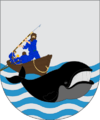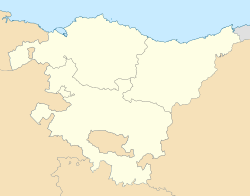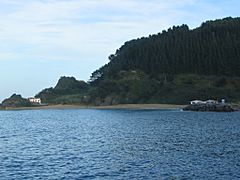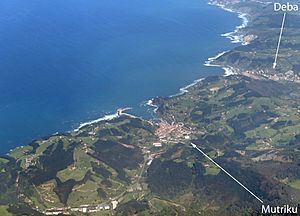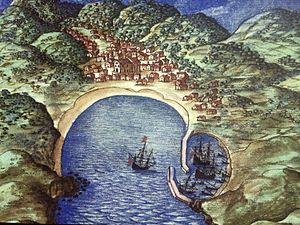Mutriku facts for kids
Quick facts for kids
Mutriku
Motrico
|
||
|---|---|---|
|
City and Municipality
|
||
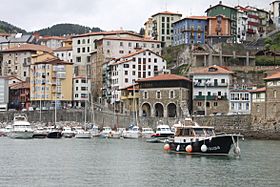
Port of Mutriku
|
||
|
||
| Country | ||
| Autonomous Community | ||
| Province | Gipuzkoa | |
| Comarca | Debabarrena | |
| Area | ||
| • Total | 27.7 km2 (10.7 sq mi) | |
| Elevation
(AMSL)
|
49 m (161 ft) | |
| Population
(2018)
|
||
| • Total | 5,354 | |
| • Density | 193.3/km2 (500.6/sq mi) | |
| Time zone | UTC+1 (CET) | |
| • Summer (DST) | UTC+2 (CEST (GMT +2)) | |
| Postal code |
20830
|
|
| Area code(s) | +34 (Spain) + 943 (Gipuzkoa) | |
| Website | www.mutriku.eus | |
Mutriku is a cool coastal town in the Basque Country region of northern Spain. It's located in the province of Gipuzkoa. About 5,000 people live here.
Mutriku is right on the Bay of Biscay coast. It's famous for having the world's first power station that uses ocean waves to make electricity! This amazing station opened on July 8, 2011. You can also find the Church of San Andrés here, which is one of the oldest churches in Gipuzkoa, built way back in 1080.
Contents
What's in a Name?
The town has two different spellings: Mutriku and Motrico. Mutriku is the older, traditional name used by the people who live there. Motrico was the official spelling from the 1200s until 1980.
In the Basque language, people use Mutriku today. This spelling became official in 1980. Since 1989, Mutriku has been the only official name accepted by the government.
People have talked a lot about where the name comes from. We don't know if it was named before the town was founded in 1209. But the town's old papers from the 1200s already mention "Motriko."
Where is Mutriku?
This small town sits on the coast of the Bay of Biscay. It's in the northwest part of Gipuzkoa. Mutriku is built on rocky cliffs right by the sea. When the tide is low, you can see many places to swim and fish.
The town has beaches at the mouths of two rivers: the Deba and the Artibai.
- The beach at the Deba river's mouth is called Ondarbeltz. Its name means 'black sand' in Basque because of its dark sand.
- The beach at the Artibai river's mouth has light gold sand.
In the middle of the town, between the two rivers, there's a natural bay with a harbor. From the harbor, you can see the whole town. It's filled with cool medieval-style buildings.
Town Areas
Besides the main town center, where most people live, Mutriku has 9 smaller neighborhoods. These include Astigarribia, Artzain Erreka, Galdona, Ibiri, Laranga, Mijoa, Mizkia, Olabarrieta, and Olatz.
Rivers and Mountains
Rivers and Streams
The Deba river forms the eastern edge of the town. Some small streams flow from the village into it, like the Olatzgoiko erreka and the Ainoerreka.
On the western side is the Artibai river. Here, the Mijoaerreka stream flows to Saturraran beach. This area collects water from Olatz and nearby mountains. Many small rivers feed into it, such as Errekabeltz and Artzainerreka.
Between the Deba and Saturraran areas, another small river flows down from Kalbario. This river runs through the valley where the town center is located. Some streams that join it are Errekaundi and Leizarreko erreka.
- Saturraran beach
The Land Around Mutriku
Mutriku's landscape is shaped by Mount Arno, which is 608 meters (about 2,000 feet) tall. This mountain is made of limestone and covered with oak trees and native forests. The land is very hilly, with steep slopes and narrow valleys. These valleys lead down to the coastline, which has cliffs and tidal areas.
How Mutriku Makes Money
Mutriku's economy has always been connected to the sea. Fishing used to be the main way people made a living. The fish caught were used in canning factories.
However, fishing has become less common. Now, only a few small fishing boats remain. Farming in the countryside is mostly for families to feed themselves. Any extra crops are sold in local markets. There are not many farm animals. People also cut down pine trees in rural areas.
New industries are growing to support the town. The canning industry is still important, but now there are also metal workshops. These workshops make metal products that are sold in the region.
The flat land near the Saturraran river mouth has allowed new businesses to grow. Today, the main business is the Yurrita e Hijos SA canning factory. Other big employers include Metec Motric SA, which makes medical tools, and Katealegaia, a workshop for people with disabilities.
Tourism is also a big part of Mutriku's economy. The town has campgrounds and many restaurants. These places also serve visitors to the nearby town of Deba. Mutriku has become a popular spot for vacation homes for people from bigger cities.
Mutriku's Story
We know people lived in this area a very long time ago. The Jentiletxea II and Iruroin Langatxo caves show signs of people living there during the Stone Age.
The town of Mutriku was officially started in 1209 by King Alfonso VIII of Castile. He gave the town a special paper that allowed them to build a wall to protect the city. You can still see parts of this old wall today!
The town grew quickly in the Middle Ages. Important palaces and tall tower houses were built for rich families and people involved in trade and the military. Sadly, in 1553, a big fire destroyed much of the town. Only stone houses survived, while all the wooden ones were lost.
In the late 1800s, Evaristo de Churruca designed new docks for the port. Over time, problems with the original designs appeared. In the mid-1900s, the docks were changed by Ramon Iribarren Cavanilles to fix issues with waves.
Later, as fishing became less popular, Mutriku started focusing more on tourism. To make the harbor better for boats and attract tourists, a new seawall was built outside the old harbor. This new seawall is where the amazing wave-powered electricity plant is located!
In the 2000s, another big project happened. A direct road to the harbor was built. This helped reduce heavy traffic in the old town center. The roads to Deba and Ondarroa were also improved.
Cool Buildings and Monuments
- Iglesia de Nuestra Señora de la Asunción: This is a beautiful church with a grand staircase. Inside, you can see a sculpture of Christ made by the famous artist El Greco.
- Palace Galdona: A baroque-style palace with a cool design and a large family crest.
- House Churruca: Built in 1731, this house was ordered by General Gaztañeta.
- Zabiel Palace: This palace from the 1500s has an impressive roof and family crest.
- Home of Churruca: An 18th-century building with the Churruca family crest. Cosme Damián Churruca was born here.
- Lonja Zaharra: This 18th-century building used to be the fish market. Now it's a social center for the Navy.
- Berriatúa Tower: This tower is older than the 1553 fire and is made of yellow sandstone. It has amazing wood carvings on its doors and windows.
- Montalivet Palace: Designed by architect Ignacio Ibero in the 1700s.
- House Olazarra-Mizquia: This 17th-century stone house has a large family crest.
- Church of San Andrés de Astigarribia: This church is considered one of the oldest in Gipuzkoa. It has very old elements, like a horseshoe-shaped window arch. Studies show these parts are from the 11th century.
Fun Festivals
Mutriku celebrates several exciting festivals throughout the year:
- Berdel Eguna (Day of Mackerel): This festival usually happens on the first Saturday of April. It celebrates the mackerel fish!
- Malen Jaiak (Festival of Mary Magdalene): This festival takes place from July 21st to 25th.
- Kalbaixoko Jaiak (Festival of Kalbario): Celebrated from September 14th to 16th.
- Gaba Beltza (Black Night): This is Mutriku's own version of Halloween. It's held on the Saturday closest to October 31st, or sometimes on October 31st itself.
Famous People from Mutriku
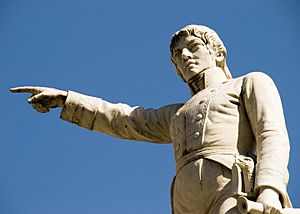
Many notable people have come from Mutriku, including:
- Juan Gamboa (15th century): A General.
- Juan Antón de Astigarribia (16th century): A Trader.
- Domingo de Irure (16th century): An admiral who fought against Francis Drake.
- José Antonio de Gaztañeta (1656-1728): An admiral and naval architect.
- Cosme Damián de Churruca y Elorza (1761-1805): A scientist and Navy officer, known as a hero of the Battle of Trafalgar.
- Evaristo de Churruca (1841-1917): An engineer and the first Count of Mutriku.
- Juan Pesón, also known as Juan de Landa (1894-1968): A famous Actor.
- José María Pagoaga (1952-1995): A Handball player.
- Sabino Andonegui (1931): A Football player and coach.
- Dionisio Urreisti (1942): A Football player.
- Juan Carlos Pérez Gómez (1958): A musician and member of the band Itoiz.
- Peio Arreitunandia (1974): A Professional cyclist.
- Asier Illarramendi (1990): A former Real Madrid footballer, now playing for Real Sociedad.
See also
 In Spanish: Motrico para niños
In Spanish: Motrico para niños


